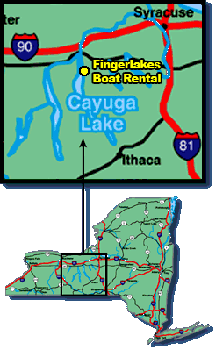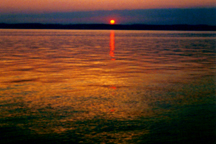Cayuga Lake is the longest of western New York's glacial Finger Lakes, and is the second largest in surface area (marginally smaller than Seneca Lake) and volume. It is just under 40 miles long. Its average width is 1.7 miles, and it is 3.5 miles wide at its widest point near Aurora. It is approximately 435 feet deep at its deepest point.
Location
The lake has one small island near Union Springs, Frontenac Island, which is one of only two islands in all of the Finger Lakes.
Ithaca, New York, site of Cornell University, sits at the southern end of Cayuga Lake. Cornell's alma mater or official school song makes reference to its position "Far Above Cayuga's Waters".
Villages and settlements along the east shore of Cayuga Lake include Myers, King Ferry, Aurora, Levanna, Union Springs, and Cayuga. Settlements along the west shore of the lake include Sheldrake, Poplar Beach, and Canoga.
Geographical characteristics
Cayuga Lake is located at 42.2 N, 76.1 W; 116.4m above sea level. Its depth, steep east and west sides with shallow north and south ends is typical of the Finger Lakes, as they were carved by glaciers during the last ice age.
Length: 61.4 km
Average Width: 2.8 km
Maximum Depth: 132 m
Surface Area: 172 sq.km
Mean Depth: 54.5 m
Catchment Area: 2,033 sq.km (37.1% natural forest, 58% active agricultural)
Main Islands: 1, Frontenac
Main Outflows: 1
The water level is regulated by the Mud Lock at the north end of the lake. It is connected to Lake Ontario by the Erie Canal and Seneca Lake by the Seneca River. The lake is drawn down as winter approaches to minimize ice damage and to maximize its capacity to store heavy spring runoff.
The north end is dominated by shallow mudflats and is an important stopover for migratory birds, where Montezuma National Wildlife Refuge is located.
The southern end is also shallow and often freezes during the winter.
Human impact
The fish population is managed and substantial sport fishing is practised, including smelt, lake trout and smallmouth bass fishing.
Cayuga lake is very popular among recreational boaters. A large state marina and boat launch is located at the southern end of the lake in Ithaca (Allan H. Treman State Marine Park, the largest inland marina in New York). There is also a yacht club on the western shore a few miles north of Ithaca, and several other marinas and boat launches scattered along the lake shore.
The lake is used both for drinking water and waste disposal, although this is no longer legal and very uncommon. There are also several lake source cooling systems that are in operation on the lake, whereby cooler water is pumped from the depths of the lake, warmed, and circulated in a closed system back to the surface. One of these systems, which is operated by Cornell University and began operation in 2000, was controversial during the planning and building states for potential negative environmental impact; however, all the environmental impact reports and scientific studies have shown that the Cornell lake source cooling system has not yet and will not likely have any measurably significant environmental impact. Furthermore, Cornell's system pumps significantly less warm water back into the lake than others further north which have been operating for decades.
BACK
NEXT
The above information uses content from the English Wikipedia. The original Finger Lakes content was at wikipedia: Finger Lakes and the Cayuga Lakes content was at: Wikipedia: Cayuga Lake. The list of authors can be seen in the Finger Lakes History and the Cayuga Lake History . Thisa content of Wikipedia is available under the GNU Free Documentation License.







